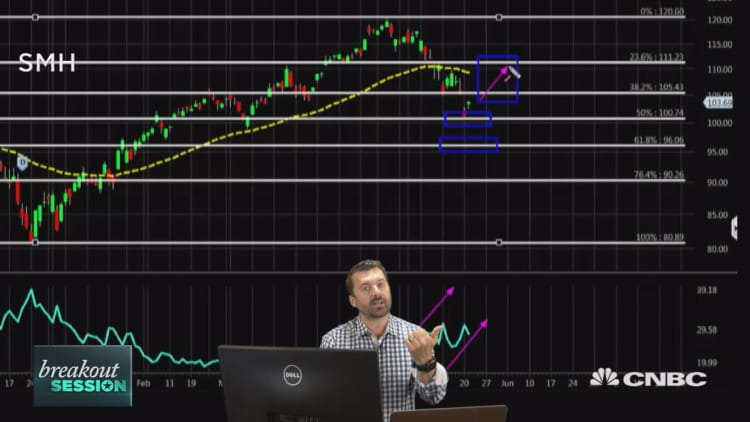
The chip carnage on Wall Street isn't stopping one trader.
As Qualcomm shares dropped after a judge ruled that the semiconductor company engaged in unlawful business practices, TradingAnalysis.com founder Todd Gordon had his eye on the collateral damage: the VanEck Vectors Semiconductor ETF.
That ETF's nearly 2% drop on Wednesday presents more of an opportunity than a sign of trouble, Gordon argued on CNBC's "Trading Nation."
"The semis have led us on the way down," he said, adding that they also led stocks higher in early 2019. "I think support has now been reached, and they are in a worthy spot of a low-risk, long setup here with a very clearly defined stop loss."
Gordon noted that the VanEck Vectors Semiconductor ETF, often referred to by its ticker, SMH, recently dropped close to a key floor of support at the $100.74 level. That drop also happened to retrace about 50% of its run from its 2019 low to its high, which traders who use Fibonacci analysis to find patterns in the stock market, including Gordon, see as a bullish sign.
"So, you have an old low back here, you've got the 50% retracement offering some support, plus we see a market that is beginning to stabilize," Gordon said. "I think it's a good opportunity to short ... expensive puts rather than buying expensive calls, so I'd like to set up a trade here, a short put with a protective long put below that is known as a put credit spread."
By using a put credit spread, Gordon is assuming the stock will see a moderate move higher. To do this, he sold a put expiring on June 21 around the SMH's current trading price of $102, then bought a June 21 put at lower than the trading price, at $98, for a lower cost. The difference was a net credit of $118 per spread, which represents the maximum potential profit, Gordon explained.
"What we want to happen here in this trade is, one, we'd like to see this bounce continue back up into this range here, and if that bounce continues, we'll be right from a directional aspect," he said. "But if we do get the bounce, you also see that implied volatility start to drop away. That will hurt the put that we're short more than the put that we're long. Net benefit is good for our trade."
As of Gordon putting on this trade Tuesday, his maximum loss was $282, which he got by subtracting the credit he received from the cost of the entire spread.
But "$282 should not be on the table," he said. "We're not going to hold this trade all the way to expiration. If the trade is not working, like, for instance, dropping below the $100 region, we'll close the trade [and] we will face less than a max loss of $282. So, the reward-to-risk ratio is much more in line."
The SMH has gained nearly 17% year to date despite concerns tied to U.S.-China trade negotiations, in which technology and semiconductors in particular have emerged as key issues.






